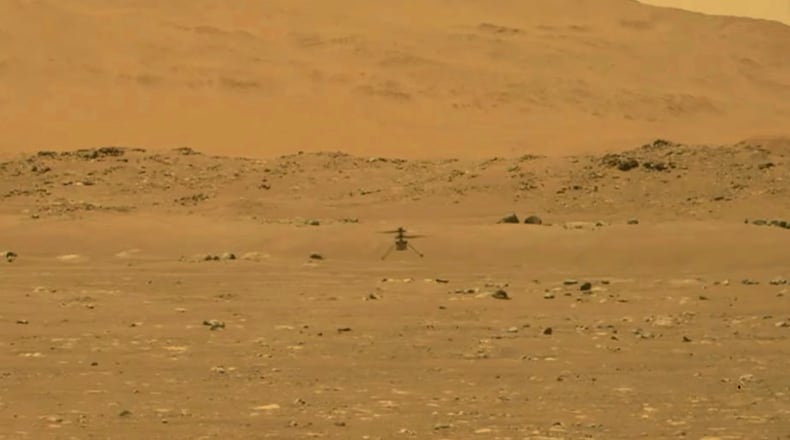Before Ingenuity was loaded onto the Perseverance rover, engineers at NASA’s Jet Propulsion Laboratory attached a swatch of fabric that once covered the wings of the Wright Flyer under the helicopter’s solar panel, ensuring the Wrights play a part in the first flights on Earth and Mars. While this isn’t the first time NASA has taken a piece of Wilbur and Orville’s legacy to space – Apollo 11 flew small pieces of fabric and wood from the Flyer to the Moon and back – the fabric on Ingenuity will remain on Mars in the area now known as Wright Brothers Field. With Monday’s short test flight complete, Ingenuity is halfway through its 30-Martian-day flight test window and will aim to make its second flight later this week.
There are other Ohio connections to Mars exploration. For example, a team at NASA Glenn worked with the Department of Energy to develop the power generation system for the Perseverance and Curiosity rovers. The reliable and predictable energy source provides decades of power for missions bound for the darkest, dustiest, and most distant places in our solar system.
This type of progressive exploration has become standard business for NASA. We’ve done so successfully in low-Earth orbit on the International Space Station, with humans on the Moon during Apollo, and with several robotic wanderers on Mars. But now it’s time for us to make missions to the Moon and Mars longer, sustainable, and more complex.
We’ll do this with the Artemis program, which will soon send the first woman and first person of color to the Moon to establish a long-term human presence. The only way humans can truly prepare for Mars is to use the Moon as a proving ground to develop the tools and “know-how” for prolonged exploration, and Artemis provides this opportunity.
When these missions launch to the Moon, Ohio will again be along for the ride. The staff at NASA Glenn is focused on making Artemis successful so we can eventually send astronauts to Mars. We are helping to build and test the Orion spacecraft and the Space Launch System rocket, which are the only spacecraft capable of sending humans back to the Moon and beyond. These two vehicles form the backbone of our exploration capabilities, while we develop an orbiting lunar outpost called Gateway and new landers, both of which feature Glenn contributions.
All of NASA’s Moon to Mars efforts contribute significantly to the state’s economic health. However, none of this will be possible without your support and the support of Ohio. All 50 states are bringing their expertise to bear for Artemis, but few are contributing as much as we are. Companies from across the state – 124 in total – are contributing to Artemis, which makes Ohio one of the Top 10 states supporting our nation’s space exploration efforts.
With each launch to the Moon or Mars, another piece of Ohio ascends to the heavens, and we’ll know each was successful because of our people, our expertise and our unrivaled contributions to aerospace.
We’re going to the Moon, so we can stay on Mars. Parts of Ohio are already there, and I hope you’ll come with us.
Marla Pérez-Davis is the director of NASA’s Glenn Research Center in Cleveland.
About the Author
